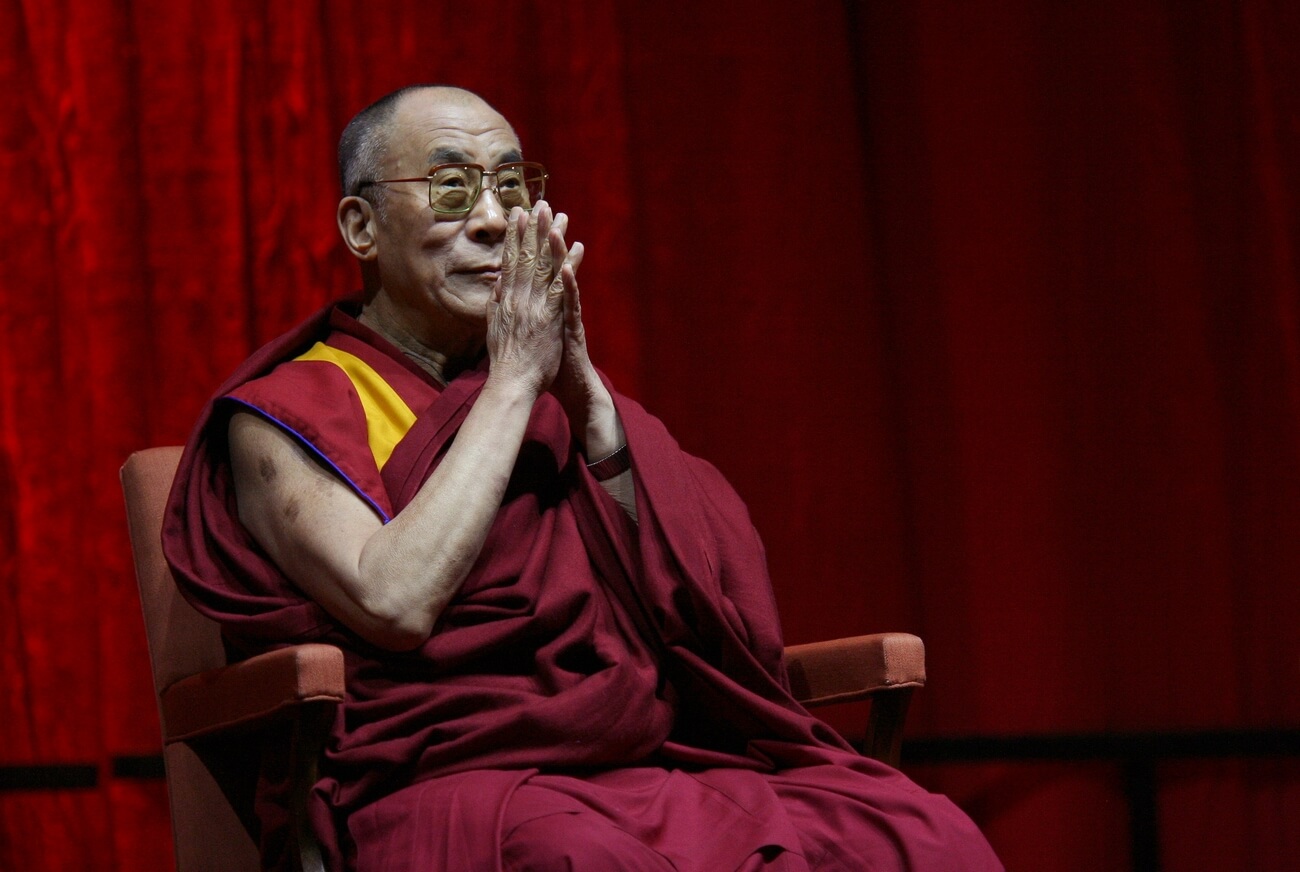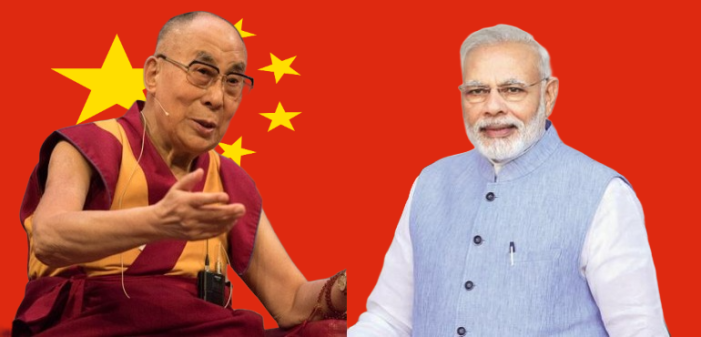It was expected that His Holiness the Dalai Lama, Tibet’s highest spiritual leader, would announce plans for his successor on July 6, the day he would turn 90. However, by doing so four days earlier this morning, he may have deprived the communist rulers in Beijing of any opportunity to take preemptive action against the legitimacy of his authority to choose a successor.
It is widely recognized now that the choice of who will be the 15th Dalai Lama to continue the 600-year-old tradition of being Tibet’s supreme leader is not simply a religious matter within Tibetan Buddhism. The decision has significant geopolitical implications for Communist China, on the one hand, and the free world, particularly for India, on the other.
The Dalai Lama, who is the 14th incarnation, said on Wednesday that the non-profit Gaden Phodrang Trust, which he set up to maintain and support the tradition and institution of the Dalai Lama, has the sole authority to recognize his future reincarnation in consultation with the heads of Tibetan Buddhist traditions.
“They should accordingly carry out the procedures of search and recognition in accordance with past tradition … no one else has any such authority to interfere in this matter,” he emphasized.
He said he had received multiple appeals over the past 14 years from the Tibetan diaspora in exile, Buddhists from across the Himalayan region, Mongolia, and parts of Russia and China, “earnestly requesting that the institution of the Dalai Lama continue.”
It may be noted that in 2011 when the Dalai Lama gave up his political power in favour of the democratically elected leader of the Tibetans-in-exile through their temporary parliament in Dharamsala in the Indian state of Himachal Pradesh (it also houses the Tibetean government in-exile, more accurately he “Kashag ” or Central Tibetan Administration), his successor should be” found in a free country, not under Chinese control”.
Giving his reasons for making the statement, the Dalai Lama had then said: “The authoritarian rulers of the People’s Republic of China, who as communists reject religion, but still involve themselves in religious affairs, have imposed a so-called re-education campaign […] concerning the control and recognition of reincarnations […] This is outrageous and disgraceful. The enforcement of various inappropriate methods for recognizing reincarnations to eradicate our unique Tibetan cultural traditions is doing damage that will be difficult to repair.”
He added: “Moreover, they say they are waiting for my death and will recognize a 15th Dalai Lama of their choice. It is clear from their recent rules and regulations and subsequent declarations that they have a detailed strategy to deceive Tibetans, followers of the Tibetan Buddhist tradition, and the world community. “Therefore, while I remain physically and mentally fit, it seems important to me that we draw up clear guidelines to recognize the next Dalai Lama so that there is no room for doubt or deception.”
More importantly, in his book “Voice for the Voiceless”, published in March this year, the Dalai Lama had also added that his successor would be “born outside China”.
After all, Yonten Gyatso, the 4th Dalai Lama, was born in Mongolia, and the 6th Dalai Lama, Tsangyang Gyatso, was born in present-day Arunachal Pradesh, India, in a region known as Mon Tawang. Yonten Gyatso was the great-grandson of Altan Khan, a Mongolian ruler, and was born in 1589. Tsangyang Gyatso, on the other hand, was born in 1683.
Beijing’s reaction to the Dalai Lama is consistently critical and dismissive. China views the Dalai Lama as a separatist and accuses him of undermining China’s sovereignty over Tibet. They maintain that any successor must be approved by the Chinese government and adhere to Chinese laws and religious traditions.
Predictably, therefore, China has responded to the Dalai Lama’s assertion today by saying that the reincarnation “must be approved by the central government…. The reincarnation of the Dalai Lama, the Panchen Lama and other great Buddhist figures must be chosen by drawing lots from a golden urn, and approved by the central government,” foreign ministry spokeswoman Mao Ning told a regular news briefing, referring to a method introduced by a Qing dynasty emperor in the 18th century.

“The Chinese government implements a policy of freedom of religious belief, but there are regulations on religious affairs and methods for managing the reincarnation of Tibetan living Buddhas,” Mao said.
For Beijing, the Dalai Lama is “a political exile who is engaged in anti-China separatist activities under the cloak of religion.” The Dalai Lama, whose name incidentally is Tenzin Gyatso, fled to India with thousands of Tibetans in 1959 after a failed uprising against the communist regime of China led by Mao Zedong.
Meanwhile, the Chinese authorities have implemented a series of severe measures designed to further consolidate Beijing’s control over the Tibetan reincarnation system, including the so-called “Order No. 5” and setting up an official reincarnate lama database subject to CCP approval.
Order No. 5, or “Management Measures for the Reincarnation of Living Buddhas in Tibetan Buddhism,” was passed by the State Administration of Religious Affairs (SARA) for implementation from September 1, 2007.
The Chinese law stipulates a ban on searching for and recognizing a ‘tulku’ by ‘unauthorized’ groups and individuals, stipulating that “Reincarnating living Buddhas shall not be interfered with or be under the dominion of any foreign organization or individual.”
This also means that ‘living Buddhas’ must forfeit their status as tulku if they leave the PRC.
In other words, for China, any Buddhist lineages outside the borders of the PRC are invalid. In fact, this law makes it clear that reincarnations of ‘living Buddhas’ who do not have government approval are “illegal or invalid.”
However, the Chinese position on the Dalai Lama is not accepted internationally. The U.S. has the Tibet Policy and Support Act (December 2020), which states that the role of deciding the Dalai Lama’s reincarnation belongs to the Tibetan Buddhist system, the Dalai Lama, and other Tibetan leaders, rather than to any government.
The Act, which was incidentally legislated during Donald Trump’s presidency, makes it official U.S. policy to hold that the Dalai Lama’s succession is a strictly religious matter that can only be decided upon by the Dalai Lama and the Tibetan Buddhist community.
Under the Act, if Chinese leaders attempt to identify a future Dalai Lama, they will face sanctions that could include having their assets frozen and their entry to the U.S. denied.
The U.S. State Department is also tasked to work with like-minded countries worldwide to push back against China’s plans to install its own imposter Dalai Lama. Two bills passed in the U.S. Congress and Senate in February 2022 and July 2021, respectively, reaffirm U.S. policy regarding the Dalai Lama’s succession or reincarnation as well as the religious freedom of Tibetan Buddhists.
Similarly, under Sec 3307 of the U.S. Innovation and Competition Act, any “interference by the Government of the People’s Republic of China or any other government in the process of recognizing a successor or reincarnation of the 14th Dalai Lama and any future Dalai Lamas would represent a clear abuse of the right to religious freedom of Tibetan Buddhists and the Tibetan people”.
Equally significantly, in July 2024, President Joe Biden signed into law the bipartisan Resolve Tibet Act. If anything, this only underscores American policy in support of the Dalai Lama. In fact, in June 2024, a bipartisan U.S. Congressional delegation, including former U.S. House of Representatives Speaker Nancy Pelosi, had called on the Dalai Lama in Dharamshala.
While no European member state has developed similar legislation yet, the European Union (EU) has reaffirmed its position that China should respect the 14th Dalai Lama’s succession in accordance with Tibetan Buddhist tradition.
What About India?
Though India hosts the Dalai Lama and his followers, this writer has not come across any statement on his succession plan in recent years. Of course, the present Prime Minister, Narendra Modi, unlike most of his predecessors, has not hesitated to go on public record and state that he does talk to His Holiness, and the two have exchanged birthday wishes for one another publicly, something hitherto unthinkable. He had also warmly met the aforesaid bipartisan U.S. Commission on Tibet at his office last year.
It is worth noting that in recent years, India has not explicitly stated, much to Beijing’s disliking, that it is committed to the One-China principle in official parleys.
All told, the issue of Tibet is a geopolitical one, given that it is often described as “the third Pole” due to being Asia’s primary freshwater source and a cradle of biodiversity. And China is allegedly destabilising its ecosystem, apart from its religious and cultural edifice, something that the Dalai Lama is also fighting against.
China is undertaking numerous water-diversion projects, which impact the river systems, including the Brahmaputra, that flow into India.
India’s official policy towards the Dalai Lama is that he is an “honored guest” of India, which has provided him asylum to carry on his “spiritual” activities in the country. Although his “government-in-exile” in Dharamsala, Himachal Pradesh, is permitted, he and his followers are not allowed to engage in political activities.
On the other hand, the Dalai lama has proved to be a boon, not a bane, for India. First, his presence enhances India’s standing in the global community as a democratic nation, given the Dalai Lama’s numerous powerful supporters worldwide. It strengthens India’s credentials for offering political asylum to democratic leaders escaping and fighting oppressive authoritarian regimes.
The nearly 200,000 Tibetan refugees in India are not a burden on the country, unlike the more than millions of illegal immigrants from Bangladesh and thousands of refugees from Sri Lanka and Afghanistan.
In fact, economically, the Tibetan refugees are self-sufficient due to their many entrepreneurial activities. Unlike other refugees, they have not created a law-and-order problem in the country, and none have aspired for Indian citizenship, making it clear that they would return to their land if China guaranteed them genuine autonomy and stopped suppressing their culture and way of life.
Secondly, India cannot just sever its historical and cultural links with Tibet to please the Chinese. India is closely tied to Tibet, as two of the holiest Hindu shrines, Mount Kailash and Lake Manasarovar, are located there. Tibet is also the source of four great rivers that flow into India.
The Dalai Lama has also periodically pointed out that the Tibetans are descendants of Rupati, king of a south Indian kingdom, who escaped to Tibet with his subjects after the epic Mahabharata War.
As for the king of Tibet, it is believed that around 150 BC, a prince of the Magadha Kingdom (present-day Bihar state) escaped to Tibet after being exiled from his kingdom. Tibetans named him Nyatri Tsenpo and made him their king, marking the beginning of the Tibetan royal lineage.
In this context, one may cite the text of the talk that Lhasang Tsering, a prominent Tibetan activist, delivered on March 17, 2000, in Mumbai as part of the week-long ‘Festival of Tibet 2000’ organized by the Friends of Tibet and the Tibetan Youth Congress.
The title of his talk was ‘India’s Tibet: A Case for Policy Review’. Tsering, who is a strong advocate of Tibetan independence (and in this he differs with the Dalai Lama, who is talking of genuine autonomy within, not separation from, Communist China), says that he would prefer Tibet becoming “India’s Tibet” to being “China’s Tibet”.
Let me quote from his Bombay speech: “I have often wondered why India doesn’t stake its claim on Tibet. Between China—which seeks to exterminate the Tibetan people and to wipe out Tibetan religion and culture, and India—which gave Tibet the Buddha Dharma and has helped to save Tibetan religion and culture—there is no doubt; India has the greater claim.
“It is like the story of young Prince Siddhartha, who saves the swan that his cousin Prince Devadatta has shot. The claim of the latter rests on the grounds of having shot the swan. On the other hand, Prince Siddhartha—the future Buddha—stakes his claim on the grounds of having saved the life of the wounded swan. The King rightly awards the swan to Prince Siddhartha.
“In today’s world of realpolitik and spineless world leaders, we could hardly hope for such a decisive verdict. Nevertheless, even if only as a diplomatic exercise, why doesn’t India file a case in the International Court of Justice and also raise the issue in the United Nations to assert its claims over Tibet? In the first place, India gave Buddhism to Tibet—the life-force of Tibetan life and culture. Today, India has rendered crucial assistance and helped to save the Tibetan religion and culture. If Tibet must belong to either of its giant neighbours, then surely, it should be to India—which has helped to save Tibet, and not China—which seeks to destroy Tibet.”
Be that as it may, if the Chinese say that Tibet became a part of the Chinese empire when the great Mongol Genghis Khan annexed Tibet (most parts of it) in the early 13th century, then logically it follows that China is a part of Mongolia and does not deserve to exist as an independent nation!
Secondly, why are the Chinese not claiming a quarter of Europe, Russia, and the whole of West Asia (the Middle East) and Central Asia, since these regions also constituted the Mongol Empire of Genghis Khan?
The problem with the Chinese version of history is where to draw the line. After all, it is also a fact that the pre-Mongol history of Tibet was marked by military glory. In the eighth century, the Tibetan Empire was expanding at such a pace that, at one point, the then-Chinese emperor had to flee his capital, and a Tibetan nominee was placed on the Chinese throne.
Peace was restored in the year 821 with the conclusion of a Treaty, which clearly defined the boundaries between China and Tibet. It read: “Tibet and China shall abide by the frontiers of which they are now in occupation. All to the East is the country of Great China; and all to the west is, without question, the country of Great Tibet….”
And when one talks of recent history, the fact remains that whether it was Britain until 1947 or the former Soviet Union until 1990, the widely-held view was that Tibet belonged to “India’s sphere of influence.”
Viewed thus, the presence of the Dalai Lama and his innumerable assertions supporting India on the boundary disputes strengthens India’s claims of territorial rights during negotiations with China.
Let us remember one fundamental fact. Had Tibet remained under Chinese suzerainty, as was the case throughout history, rather than under its sovereignty, as has been the case since the 1950s, the Sino-Indian border dispute would have been resolved long ago in India’s favour. But because the Dalai Lama openly recognizes the McMahon line as the border between India and Tibet, India’s claim to the region still stands.
What this all underscores is that Tibet is a significant factor in Sino-Indian relations. India cannot wish away the Dalai Lama and Tibetans living on Indian soil and their feelings over what is happening inside Tibet. India has a vested interest in ensuring stability and tranquility in Tibet.
- Author and veteran journalist Prakash Nanda is Chairman of the Editorial Board of the EurAsian Times and has been commenting on politics, foreign policy, and strategic affairs for nearly three decades. He is a former National Fellow of the Indian Council for Historical Research and a recipient of the Seoul Peace Prize Scholarship.
- VIEWS PERSONAL OF THE AUTHOR
- CONTACT: prakash.nanda (at) hotmail.com







